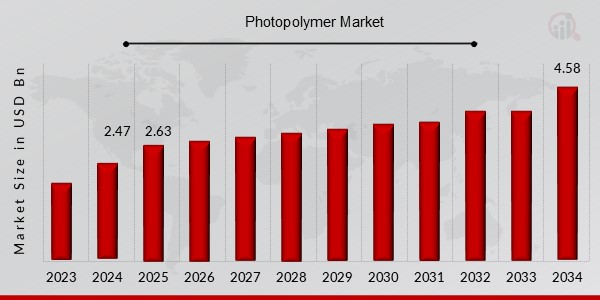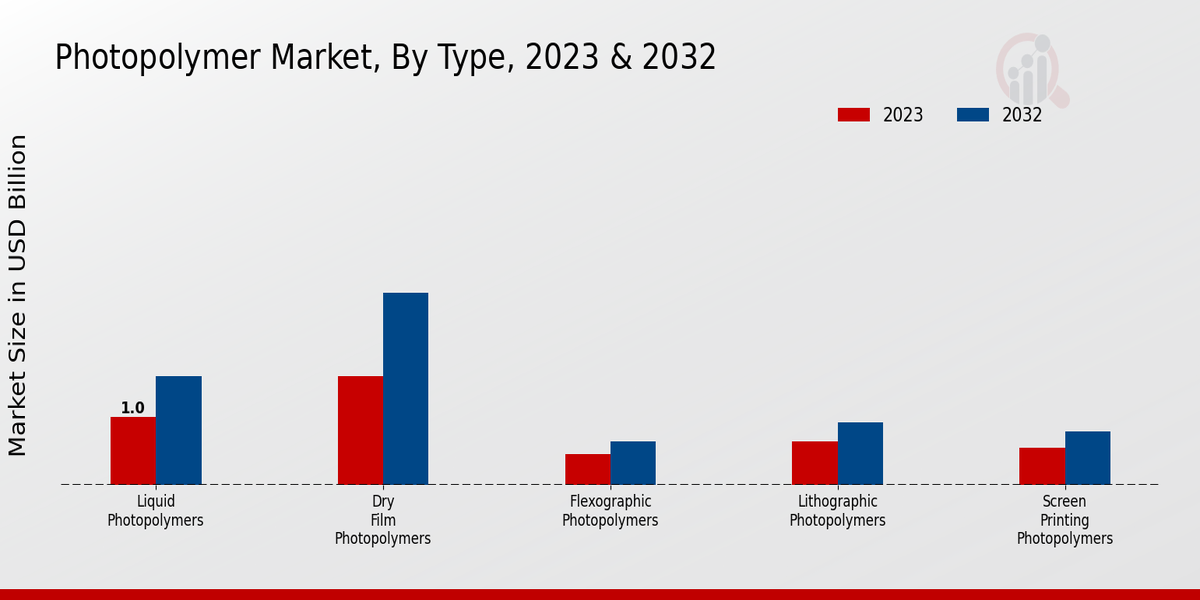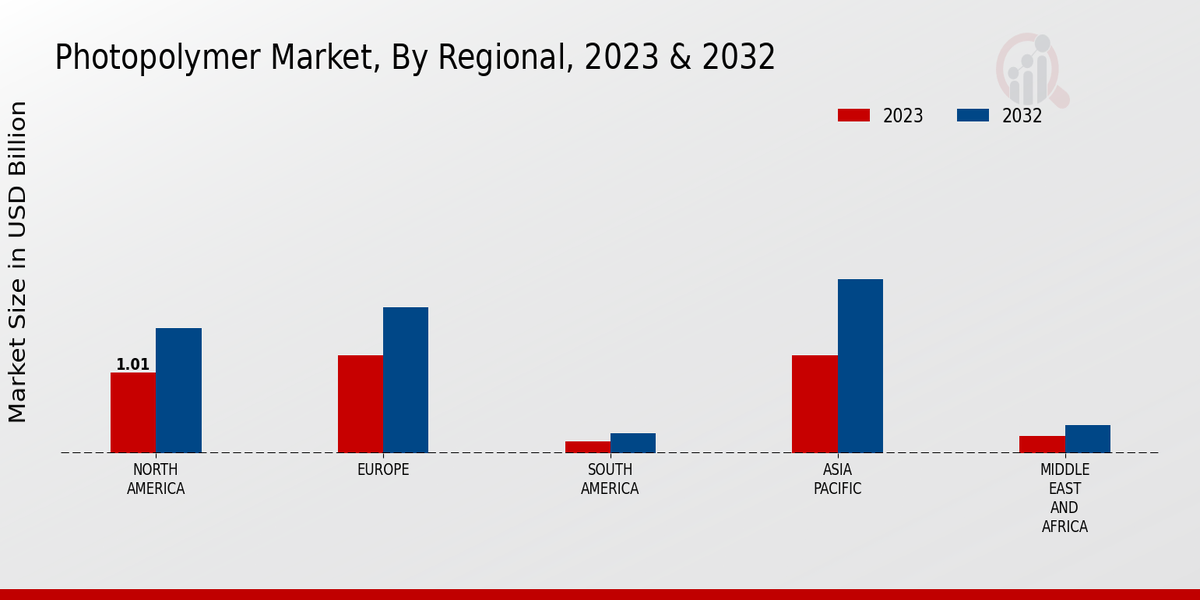Global Photopolymer Market Overview
The Photopolymer Market Size was estimated at 2.47 (USD Billion) in 2024.The Photopolymer Market Industry is expected to grow from 2.63(USD Billion) in 2025 to 4.58 (USD Billion) by 2034. The Photopolymer Market CAGR (growth rate) is expected to be around 6.4% during the forecast period (2025 - 2034).
Key Photopolymer Market Trends Highlighted
The Global Photopolymer Market is expected to witness significant growth in the coming years due to increasing demand in various end-use industries. Key market drivers include the rising demand for printed electronics, flexible packaging, and medical devices. The miniaturization of electronic devices and the advent of the Internet of Things (IoT) are fueling the growth of printed electronics, where photopolymers find applications in manufacturing sensors, circuits, and displays.In addition, advancements in healthcare technology and the growing geriatric population are driving the demand for photopolymers in medical applications such as microfluidics, tissue engineering, and drug delivery systems. The development of novel materials and prototyping techniques has also created opportunities in the prototyping and additive manufacturing industries.Current market trends include the adoption of sustainable materials, the integration of advanced imaging technologies, and the development of multifunctional photopolymers. The focus on sustainability is driving the development of bio-based and recyclable photopolymers, while advancements in imaging techniques such as multi-photon lithography enable the creation of complex and precise structures. Multifunctional photopolymers, which combine multiple properties such as conductivity, biocompatibility, and optical transparency, offer potential applications in various industries, including electronics, photonics, and medicine.

Source: Primary Research, Secondary Research, MRFR Database and Analyst Review
Photopolymer Market Drivers
Advancements in 3D Printing Technology
The growing adoption of 3D printing technology is a major driver of the global photopolymer market. Photopolymers are widely used in 3D printing processes, such as stereolithography (SLA) and digital light processing (DLP), due to their high precision, detail, and ability to create complex geometries. As 3D printing technology continues to advance and become more accessible, the demand for photopolymers is expected to increase significantly. The versatility of photopolymers, combined with the growing popularity of 3D printing for prototyping, manufacturing, and consumer applications, is driving the growth of the global photopolymer market.
Increasing Demand for Holographic Applications
The rising demand for holographic applications in various industries, such as entertainment, advertising, and security, is another key driver of the global photopolymer market. Photopolymers are essential materials for creating holograms, as they can be precisely patterned and cured to produce the desired optical effects. The use of photopolymers in holographic displays, augmented reality devices, and holographic security features is increasing, driven by the growing popularity of immersive experiences and the need for advanced security measures.The Global Photopolymer Market Industry is expected to continue to benefit from the growing demand for holographic applications.
Expansion of Electronics and Semiconductor Industries
The expanding electronics and semiconductor industries are also contributing to the growth of the global photopolymer market. Photopolymers are used in various applications within these industries, including photoresists for photolithography, encapsulants for electronic components, and optical films for displays. The increasing demand for electronic devices, such as smartphones, laptops, and wearable devices, is driving the growth of the electronics industry, which in turn is fueling the demand for photopolymers.
Photopolymer Market Segment Insights:
Photopolymer Market Type Insights
The Global Photopolymer Market segmentation by Type covers Liquid Photopolymers, Dry Film Photopolymers, Flexographic Photopolymers, Lithographic Photopolymers, and Screen Printing Photopolymers. In 2023, the Liquid Photopolymers segment held the largest market share, accounting for around 40% of the Global Photopolymer Market revenue. This dominance can be attributed to factors such as its versatility and wide range of applications in various industries, including electronics, automotive, and packaging. Dry Film Photopolymers are expected to witness significant growth during the forecast period, owing to their ease of use and cost-effectiveness.Flexographic Photopolymers are primarily utilized in the printing industry, and their demand is expected to remain steady over the coming years. Lithographic Photopolymers, employed in the production of printed circuit boards and semiconductor devices, are projected to experience moderate growth. Screen Printing Photopolymers, used in the textile and graphic arts industries, are anticipated to maintain a stable market presence. Overall, the Global Photopolymer Market segmentation by Type offers diverse options catering to specific industry requirements, with each segment contributing to the overall growth and evolution of the market.
Source: Primary Research, Secondary Research, MRFR Database and Analyst Review
Photopolymer Market Application Insights
The Global Photopolymer Market is segmented based on Application into Packaging, Printing, Electronics, Medical, and Automotive. Packaging held the largest market share in 2023, accounting for around 35% of the Global Photopolymer Market revenue. The growth of the packaging segment can be attributed to the increasing demand for flexible packaging solutions in various industries, such as food and beverage, pharmaceuticals, and consumer goods. The printing segment is expected to witness significant growth over the forecast period due to the rising demand for digital printing technologies and the growing popularity of personalized printing applications.The electronics segment is also expected to grow steadily, driven by the increasing adoption of photopolymers in the production of printed circuit boards, displays, and other electronic components. The medical segment is expected to witness a moderate growth rate, as photopolymers are used in various medical applications such as drug delivery, tissue engineering, and dental materials. The automotive segment is expected to experience gradual growth as photopolymers are used in the production of lightweight and durable automotive components.
Photopolymer Market End-Use Insights
The Global Photopolymer Market is segmented by End Use into Industrial, Commercial, and Consumer. The Industrial segment held the largest market share in 2023, accounting for over 55% of the Global Photopolymer Market revenue. This segment is expected to continue to dominate the market over the forecast period, driven by the increasing demand for photopolymers in various industrial applications, such as in the production of printing plates, electronic components, and medical devices. The Commercial segment is also expected to witness significant growth over the forecast period, owing to the rising demand for photopolymers in commercial applications, such as in the production of packaging materials, labels, and signage.The Consumer segment is expected to grow at a steady pace over the forecast period, driven by the increasing popularity of photopolymers in consumer products, such as in the production of toys, games, and sporting goods.
Photopolymer Market Viscosity Insights
The Global Photopolymer Market is segmented by viscosity into low, medium, and high. The low-viscosity segment is expected to account for the largest share of the market in 2023 due to its wide range of applications in industries such as electronics, automotive, and packaging. The medium viscosity segment is expected to grow at the highest CAGR during the forecast period due to its increasing use in 3D printing and other advanced manufacturing technologies. The high-viscosity segment is expected to account for a smaller share of the market but is expected to witness steady growth over the forecast period.In 2023, the low viscosity segment is expected to be valued at USD 1.2 billion, while the medium viscosity segment is expected to be valued at USD 0.6 billion. The high-viscosity segment is expected to be valued at USD 0.3 billion in 2023.
Photopolymer Market Regional Insights
The Global Photopolymer Market is segmented into North America, Europe, APAC, South America, and MEA. Among these regions, APAC is expected to dominate the market in the coming years due to the growing demand for photopolymers in various industries such as electronics, automotive, and packaging. The increasing adoption of 3D printing technology is also expected to drive the growth of the photopolymer market in APAC. North America and Europe are expected to hold a significant market share due to the presence of well-established players and the high demand for photopolymers in these regions.South America and MEA are expected to witness steady growth in the photopolymer market due to the increasing industrialization and the growing demand for photopolymers in these regions.
Source: Primary Research, Secondary Research, MRFR Database and Analyst Review
Photopolymer Market Key Players And Competitive Insights:
Major players in the Photopolymer Market industry are continuously working on developing new products and technologies to gain a competitive edge. Leading Photopolymer Market players are investing heavily in research and development to introduce innovative products that cater to the specific needs of end-users. Key companies in the Photopolymer Market are focusing on strategic partnerships and acquisitions to enhance their product portfolios and expand their market reach. The competitive landscape of the Photopolymer Market is expected to remain fragmented, with a number of small and medium-sized players operating alongside larger, established companies.Leading Photopolymer Market player DuPont Photopolymers is known for its wide range of photopolymer products, including flexographic printing plates, screen printing emulsions, and photoresists. The company has a strong global presence and serves a diverse customer base across various industries. DuPont Photopolymers is committed to sustainability and has a dedicated research and development team focused on developing environmentally friendly products and technologies.A notable competitor in the Photopolymer Market is Toyobo, which is recognized for its high-quality photopolymer printing plates. The company has a strong presence in the automotive and electronics industries and is constantly innovating to meet the evolving needs of its customers. Toyobo is known for its advanced printing technologies and has a global network of subsidiaries and distributors to support its customers worldwide.
Key Companies in the Photopolymer Market Include:
Photopolymer Market Industry Developments
The global Photopolymer Market is poised to grow from USD 2.18 billion in 2023 to USD 3.8 billion by 2032, exhibiting a CAGR of 6.38% from 2024 to 2032. Advancements in 3D printing and the increasing adoption of photopolymers in various industries, such as electronics, packaging, and healthcare, contribute to this growth.Recent news in the Photopolymer Market includes the launch of new products by key players. For instance, in January 2023, BASF introduced a new range of photopolymers for use in 3D printing applications. These new photopolymers offer improved mechanical properties and printability, making them suitable for a wider range of applications.
Photopolymer Market Segmentation Insights
Photopolymer Market Type Outlook
- Flexographic Photopolymers
- Lithographic Photopolymers
- Screen Printing Photopolymers
Photopolymer Market Application Outlook
Photopolymer Market End-Use Outlook
Photopolymer Market Viscosity Outlook
Photopolymer Market Regional Outlook
| Report Attribute/Metric |
Details |
| Market Size 2024 |
2.47(USD Billion) |
| Market Size 2025 |
2.63(USD Billion) |
| Market Size 2034 |
4.58(USD Billion) |
| Compound Annual Growth Rate (CAGR) |
6.4% (2025 - 2034) |
| Report Coverage |
Revenue Forecast, Competitive Landscape, Growth Factors, and Trends |
| Base Year |
2024 |
| Market Forecast Period |
2025 - 2034 |
| Historical Data |
2020 - 2024 |
| Market Forecast Units |
USD Billion |
| Key Companies Profiled |
AGC, Heraeus, Henkel, Fujifilm, DuPont, Mitsubishi Chemical, Sumitomo Chemical, JSR, Toray Industries, MicroChem, Adeka, Dow Chemical, SaintGobain, BASF, Asahi Glass |
| Segments Covered |
Type, Application, End Use, Viscosity, Regional |
| Key Market Opportunities |
3D printing holography microelectronics |
| Key Market Dynamics |
Rising demand for electronics Increasing adoption of 3D printing Technological advancements |
| Countries Covered |
North America, Europe, APAC, South America, MEA |
Frequently Asked Questions (FAQ) :
The Photopolymer Market is estimated to be valued at 2.47 billion USD in 2024.
The Photopolymer Market is projected to grow at a CAGR of 6.4% from 2025 to 2034.
The Photopolymer Market is expected to reach a value of 4.58 billion USD by 2034
The packaging segment is expected to drive the growth of the Global Photopolymer Market
Some of the key competitors in the Global Photopolymer Market include Fujifilm, DuPont, and Hitachi Chemical.
The key trends driving the growth of the Global Photopolymer Market include the increasing demand for lightweight and durable packaging materials, the growing adoption of 3D printing technology, and the increasing use of photopolymers in electronics.
The challenges faced by the Global Photopolymer Market include the high cost of photopolymers, the limited availability of raw materials, and the stringent environmental regulations
The opportunities for growth in the Global Photopolymer Market include the development of new applications for photopolymers, the increasing demand for photopolymers in emerging markets, and the technological advancements in photopolymer production.
















